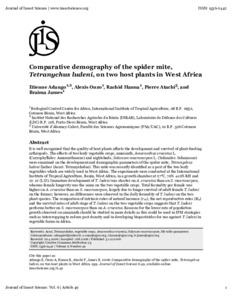| dc.contributor.author | Adango, E. |
| dc.contributor.author | Onzo, A. |
| dc.contributor.author | Hanna, R. |
| dc.contributor.author | Atachi, P. |
| dc.contributor.author | James, B. |
| dc.date.accessioned | 2019-12-04T11:18:09Z |
| dc.date.available | 2019-12-04T11:18:09Z |
| dc.date.issued | 2006 |
| dc.identifier.citation | Adango, E., Onzo, A., Hanna, R., Atachi, P. & James, B. (2006). Comparative demography of the spider mite, Tetranychus ludeni, on two host plants in West Africa. Journal of Insect Science, 6(1), 1-9. |
| dc.identifier.issn | 1536-2442 |
| dc.identifier.uri | https://hdl.handle.net/20.500.12478/3082 |
| dc.description.abstract | It is well recognized that the quality of host plants affects the development and survival of plant-feeding arthropods. The effects of two leafy vegetable crops, amaranth, Amaranthus cruentus L. (Caryophyllales: Amaranthaceae) and nightshade, Solanum macrocarpon L. (Solanales: Solanaceae) were examined on the development and demographic parameters of the spider mite, Tetranychus ludeni Zacher (Acari: Tetranychidae). This mite was recently identified as a pest of the two leafy vegetables which are widely used in West Africa. The experiments were conducted at the International Institute of Tropical Agriculture, Benin, West Africa, in a growth chamber at 27°C, 70% ±10% RH and 12: 12 (L:D). Immature development of T. ludeni was shorter on A. cruentus than on S. macrocarpon, whereas female longevity was the same on the two vegetable crops. Total fecundity per female was higher on A. cruentus than on S. macrocarpon, largely due to longer survival of adult female T. ludeni on the former; however, no differences were observed in the daily fecundity of T. ludeni on the two plant species. The comparison of intrinsic rates of natural increase (rm), the net reproductive rates (Ro) and the survival rates of adult stage of T. ludeni on the two vegetable crops suggests that T. ludeni performs better on S. macrocarpon than on A. cruentus. Reasons for the lower rate of population growth observed on amaranth should be studied in more details as this could be used in IPM strategies such as intercropping to reduce pest density and in developing biopesticides for use against T. ludeni in vegetable farms in Africa. |
| dc.description.sponsorship | Swiss Agency for Development and Cooperation |
| dc.description.sponsorship | Netherlands Organisation for Scientific Research |
| dc.language.iso | en |
| dc.subject | Acari |
| dc.subject | Tetranychidae |
| dc.subject | Vegetable Crops |
| dc.subject | Amaranthus Cruentus |
| dc.subject | Solanum Macrocarpon |
| dc.subject | Life Table Parameters |
| dc.title | Comparative demography of the spider mite Tetranychus ludeni on two host plants in West Africa. |
| dc.type | Journal Article |
| dc.description.version | Peer Review |
| cg.contributor.affiliation | International Institute of Tropical Agriculture |
| cg.contributor.affiliation | Institut National des Recherches Agricoles du Bénin |
| cg.contributor.affiliation | Université d'Abomey Calavi |
| cg.coverage.region | Africa |
| cg.coverage.region | West Africa |
| cg.coverage.country | Benin |
| cg.isijournal | ISI Journal |
| cg.authorship.types | CGIAR and developing country institute |
| cg.iitasubject | Food Security |
| cg.iitasubject | Livelihoods |
| cg.iitasubject | Nutrition |
| cg.iitasubject | Diseases Control |
| cg.iitasubject | Handling, Transport, Storage And Protection Of Agricultural Products |
| cg.iitasubject | Farm Management |
| cg.iitasubject | Plant Diseases |
| cg.iitasubject | Smallholder Farmers |
| cg.iitasubject | Pests Of Plants |
| cg.accessibilitystatus | Limited Access |
| local.dspaceid | 94548 |
| cg.identifier.doi | https://dx.doi.org/10.1673/031.006.4901 |

